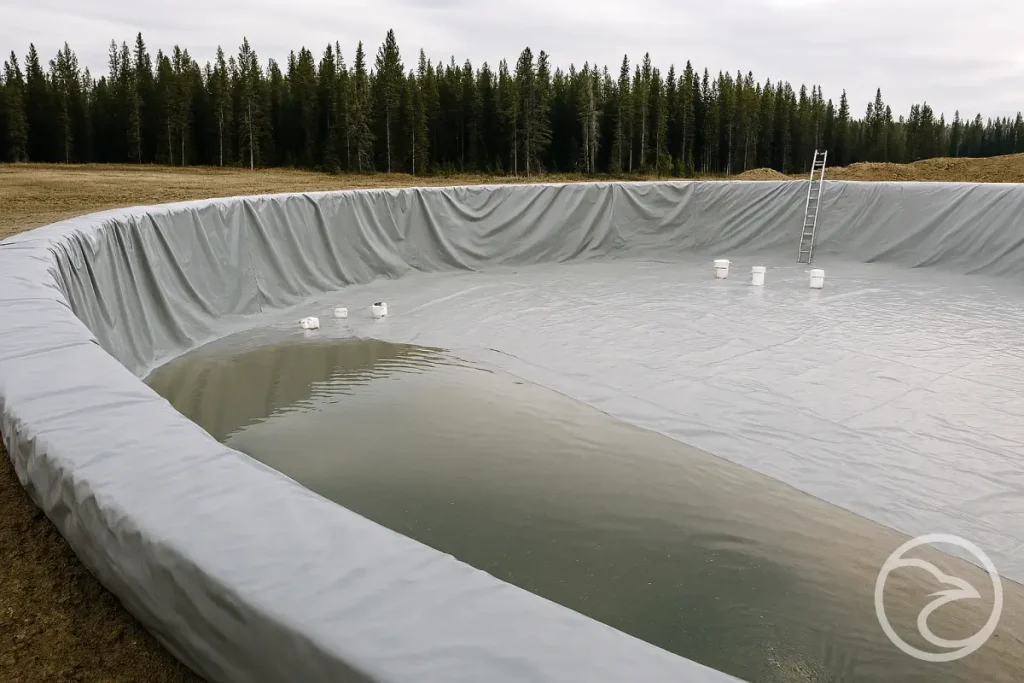Wastewater Pit Liners: Preventing Soil Contamination and Groundwater Damage
Effective wastewater containment is critical for protecting soil, groundwater, and nearby ecosystems. Across the United States, industries ranging from manufacturing and agriculture to mining and wastewater treatment rely on engineered pit liners to safely control contaminated liquids. Without proper lining, wastewater can seep into surrounding soil, corrode infrastructure, and result in costly EPA violations. Wastewater pits often contain industrial effluent, chemicals and runoff that require secure containment solutions. For facilities that manage contaminated liquids, high-quality industrial pit liners play a critical role in preventing leaks and environmental damage. At Raven American Tanks, we manufacture and install durable, chemical-resistant wastewater pit liners designed to safeguard facilities from environmental damage and regulatory risk. Below, we break down how wastewater pit liners work, why they are essential, and how to choose the right liner for your operation. What are Wastewater Pit Liners? A wastewater pit liner is a protective membrane installed inside pits, lagoons, or containment areas used to store or process industrial wastewater. These liners create a secure barrier between contaminated liquid and the surrounding soil, preventing leaks that could lead to groundwater pollution. Wastewater pits often contain: Because these liquids may contain corrosive chemicals, heavy metals, oils, fats, or suspended solids, wastewater pits must use highly durable, reinforced liners that can withstand harsh environments. How Contamination Happens without Proper Lining If a pit is left unlined—or lined with the wrong material—wastewater can gradually penetrate the ground, creating an invisible but severe environmental hazard. 1. Soil infiltration Contaminants like hydrocarbons, acids, and dissolved metals quickly bind to soil particles, degrading soil structure and reducing fertility. 2. Groundwater pollution Wastewater seepage can migrate into aquifers, creating long-term public health risks. Once groundwater is contaminated, remediation becomes extremely expensive and may take decades. 3. Chemical leaching during storage Industrial wastewater often contains corrosive compounds that break down concrete pits, accelerating leaks. 4. EPA violations and liability Under the U.S. Clean Water Act (CWA) and Resource Conservation and Recovery Act (RCRA), facilities are responsible for preventing wastewater discharge into soil and water. Unlined pits are a major compliance issue and can lead to fines, cleanup orders, or shutdowns. Soil and groundwater contamination is one of the most serious risks associated with unlined wastewater pits. Even small leaks can migrate into aquifers and compromise drinking water sources, which are strictly regulated under EPA groundwater protection standards. Why Wastewater Pit Liners are Essential Compliance With U.S. Environmental Standards Many facilities rely on pit liners to meet: Failure to contain wastewater can result not only in fines but also mandatory corrective action. Resistance to Chemical and Biological Corrosion Wastewater can include corrosive substances such as: Liners made from reinforced PVC, HDPE, or LLDPE act as a stable barrier that resists chemical attack. Groundwater Protection The primary role of a wastewater pit liner is to keep contaminants out of local aquifers and drinking water sources. This is particularly important in regions with sandy or permeable soils—common in the Midwest, Southwest, and coastal states. Materials Used in Wastewater Pit Liners Choosing the right liner material depends on the chemical profile of the wastewater, pit depth, UV exposure, and regulatory requirements. PVC (Polyvinyl Chloride) Liners HDPE (High-Density Polyethylene) Liners LLDPE (Linear Low-Density Polyethylene) Liners Reinforced Geomembranes Composite membranes reinforced with mesh or polyester scrim for: Facilities often choose reinforced membranes for heavy industrial or mining wastewater containment. Key Features of a High-Performing Wastewater Pit Liner Reinforced liners prevent wear caused by settling layers of sediment. Maintenance: Ensuring Long-Term Performance Even the most durable liner requires periodic inspection. Routine Inspections Facilities should check for: Professional Repairs Small punctures or tears can be repaired using patch welding techniques. Replacement Indicators A liner should be replaced if: Industries that Depend on Wastewater Pit Liners Wastewater pit liners are used widely across U.S. industries, including: How to Choose the Right Wastewater Pit Liner The optimal liner depends on: Conclusion Wastewater pit liners play a vital role in preventing soil contamination, protecting groundwater, and ensuring environmental compliance. Whether your facility deals with industrial wastewater, agricultural effluent, or processed liquids, a high-quality liner is essential for safe and efficient operations. Raven American Tanks provides custom-engineered wastewater pit liners designed to meet U.S. environmental standards and withstand demanding industrial conditions. If you need installation, replacement, or guidance on choosing the right liner—our team is ready to help.
Wastewater Pit Liners: Preventing Soil Contamination and Groundwater Damage Read More »

